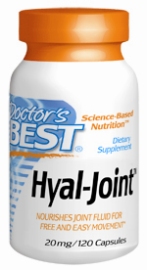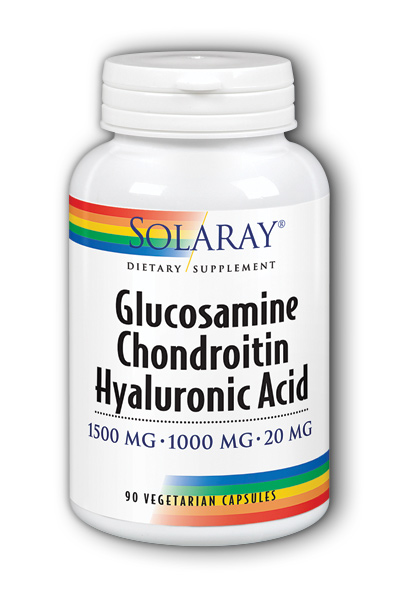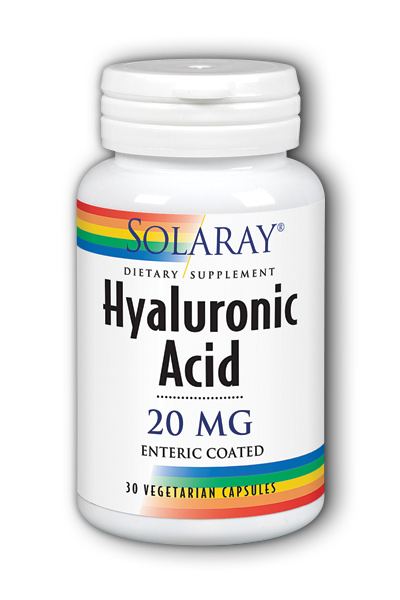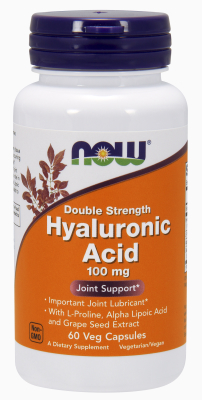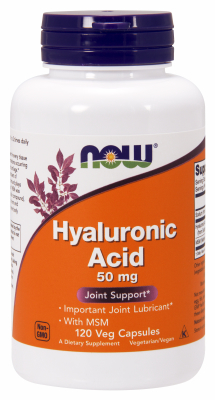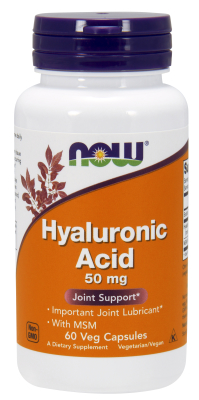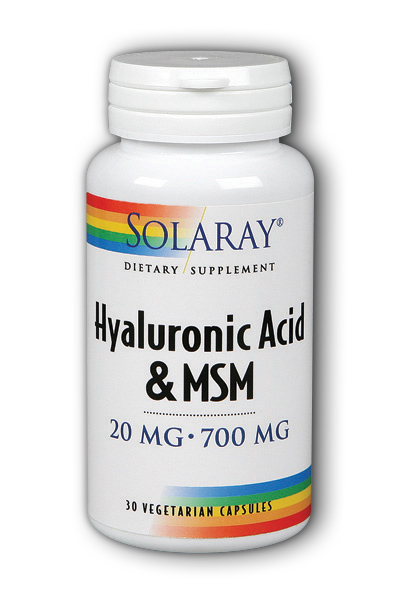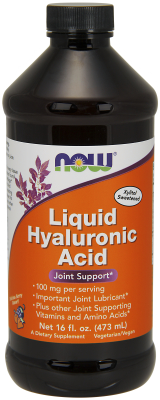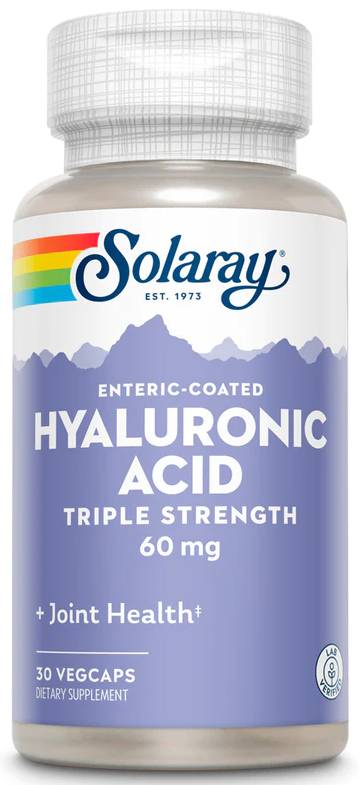- UPC: 753950001947
- # DRB-00194
Hyal-JointSupplement Facts:
serving size 2 capsules Hyal-Joint (Hyaluronic Acid (from rooster comb cartilage) - 24mg) ......... 40mg Other ingredients: Rice powder, silicon dioxide, magnesium stearate (vegetarian), gelatin capsule. Suggested adult use: 2 capsules twice daily for one or more months, followed by 1 capsule twice daily for one or more months, followed by a maintenance dose of 1 capsule daily.
Hyal-Joint™ is a patent-pending extract of rooster combs composed of 60% hyaluronic acid along with collagen and glycosaminoglycans that form the structural components of connective tissue. The Importance of Hyaluronic Acid
Hyaluronic acid, also known as “hyaluronan”, or “HA”, is a large polysaccharide (complex sugar) molecule composed of disaccharides linked together in a chain. It belongs to a family of biological compounds called “glycosaminoglycans” (GAGs). These complex, versatile molecules impart structural strength and integrity to cells while providing elasticity and lubrication to joints and other body parts. GAGs can be thought of as anatomic “glue and grease” that keep bodily structures strong, supple and moving together smoothly. Our tissues contain more hyaluronic acid than any other GAG.1
Humans are fluid-based organisms; the body contains up to 70% water. Cells have a high water content along with various intracellular (inside the cell) organelles. The extracellular (outside the cell) matrix itself is a water world. This non-cellular environment is highly dynamic: a complex bio-field in which cell-to-cell communication and a grand array of other biochemical functions take place.
The extracellular matrix provides the cushioning and support for joints, the bone-to-bone connections that allow us to move. For this to work according to nature’s design, fluids occupying the spaces between bones need to be slippery and elastic in order to keep friction from building up as joints move harmoniously in their life-long anatomic dance.
Hyaluronic acid is essential for the viscosity of joint fluid; the “slipperiness” that allows us to move freely and easily. Hyaluronic acid is remarkably viscous: 5000 times more so than water! The synovial membrane, the protective layer surrounding joints, is rich in hyaluronic acid––the pliancy and resiliency of our joints would be non-existent without it; we’d be like the Tin Man waiting for someone to bring us an oil can so we could move once again. When you feel the spring in your step and the bounce in your run, thank nature for hyaluronic acid; you would never experience the joy of movement if it were not for this amazing biological substance that permeates your entire body. Hyal-Joint™ Absorption
Intestinal absorption of Hyal-Joint™ has been demonstrated through a laboratory procedure that utilizes spectrophotometric analysis to measure the amount of glycosaminoglycans in tissue cultures.2 Application of this technique to an in vitro model of intestinal absorption produced absorption values of approximately 38, 22 and 9 percent in the duodenum, jejunum and ileum, respectively.3 Based on these results, it can be theorized that 50 percent or more of the hyaluronic acid in Hyal-Joint™ is absorbed following oral consumption.
Hyal-Joint™ ––Like the Body’s Own HA
Hyal-Joint™ has a molecular weight of one million daltons (units of measure for the size of molecules). This high molecular weight means the hyaluronic acid in Hyal-Joint™ is similar to the HA in joints (“native” HA). Animal studies suggest 500,000 to 1,000,000 daltons is the optimum molecular weight range for HA supplements.1 According to a published review on hyaluraonic acid supplements: “Products using high molecular weight HA match the identity of native HA in the body and from the scientific literature.”4
Helps Maintain Healthy, Smooth Joint Function*
The effect of Hyal-Joint™ on joint function and comfort in humans was recently studied in a pilot clinical trial. The study subjects were men and women at least 40 years old who often experienced noticeable deterioration of joint comfort. The participants were randomly assigned to take either 80 mg of Hyal-Joint™ or a look-alike placebo capsule every day for eight weeks. Each participant’s joint health and function status was evaluated at the beginning of the trial, and again after four and eight weeks. Assessment was conducted using the WOMAC Index, a self-administered questionnaire that measures 24 parameters of joint function, and a 36-question survey that generates a comprehensive profile of physical and mental well-being. Statistical analysis of the data showed Hyal-Joint™ to be effective for improving physical function, joint comfort and quality of life.5
Nourishes Joint Fluid for Free and Easy Movement*
As described earlier, hyaluronic acid is necessary for the synovial fluid to perform its lubricating function in joints. Studies on the intra-articular injection of hyaluronic acid into joints suggest that exogenous (coming from outside the body) HA potentiates HA production in synovial membrane cells (synoviocytes).6 In a cell culture (in vitro) study, Hyal-Joint™ effectively stimulated synthesis of hyaluronic acid in synoviocytes.7 In another in vitro study, HA with a molecular weight above 500,000 daltons stimulated HA synthesis by synoviocytes, whereas HA with a lower molecular weight “showed little or no effect”.8
It has been observed that a diminished content of hyaluronic acid in joints––with a concomitant loss of its elastic, lubricating benefits––occurs in tandem with sub-optimal joint health and function.9 As joint health declines, the amount of hyaluronic acid in synovial fluid (intra-articular content) is reduced.10,11 Hyal-Joint™ was studied for its ability to increase the hyaluronic acid concentration in joints of horses with poorly functioning joints. In a small pilot trial, oral administration of Hyal-Joint™ for 60 days measurably increased both the quantity and quality of hyaluronic acid in the tarsocrural joint (the articulation between the tarsal bone of the foot and the tibia and fibula), while at the same time improving walking ability.12 Safety Suggested Adult Use: 2 capsules twice daily for one or more months followed by 1 capsule twice daily for one or more months followed by a maintenance dose of 1 capsule daily. Does Not Contain: milk, egg, wheat, corn, sugar, sweeteners, starch, salt, or preservatives. Scientific References 1. Ghosh P, Guidolin D. Potential mechanism of action of intra-articular hyaluronan therapy in osteoarthritis: are the effects molecular weight dependent? Semin Arthritis Rheum 2002;32(1):10-37.
2. Farndale RW, Sayers CA, Barrett AJ. A direct spectrophotometric microassay for sulfated glycosaminoglycans in cartilage cultures. Connect Tissue Res 1982;9(4):247-8.
3. Unpublished study performed at the Department of Pharmacology, Therapeutics and Toxicology; University of Barcelona, Spain.
4. Bucci LR, Turpin AA. Will the real hyaluronan please stand up? J Appl Nutr 2004;54(1):10-33.
5. Kalman DS, Heimer M, Valdeon A, et al. Effect of a natural extract of chicken combs on pain relief and quality of life in subjects with knee osteoarthritis: a pilot randomized double-blind placebo-controlled trial. Nutrition Journal 2008; 7:3.
6. Jackson DW, Scheer MJ, Simon TM. Cartilage substitutes: overview of basic science and treatment options. J Am Acad Orthop Surg 2001;9(1):37-52.
7. Unpublished study conducted at the Rheumatology Service Research Unit; Hopsital Juan Canalejo; L Coruña, Spain.
8. Smith MM, Ghosh P. The synthesis of hyaluronic acid by human synovial fibroblasts is influenced by the nature of the hyaluronate in the extracellular environment. Rheumatol Int 1987;7(3):113-22.
9. Miltner O, Schneider U, Siebert CH, et al. Efficacy of intraarticular hyaluronic acid in patients with osteoarthritis-a prospective clinical trial. Osteoarthritis Cartilage 2002;10(9):680-6.
10. Brockmeier SF, Shaffer BS. Viscosupplementation therapy for osteoarthritis. Sports Med Arthrosc Rev 2006; 14(3):155-62.
11. Dahl LB, Dahl IM, Engström-Laurent A, Granath K. Concentration and molecular weight of sodium hyaluronate in synovial fluid from patients with rheumatoid arthritis and other arthropathies. Ann Rheum Dis 1985;44(12):817-22.
12. Martínez-Puig D, Carmona JU, Argüelles D, et al. Oral hyaluronic acid (Hyal-Joint™) administration improves OCD clinical symptoms and slightly increases intra-articular concentration of hyaluronic acid in a horse model: a pilot survey. Presented at the World Congress on Osteoarthritis. Dec 6-9, 2007; Ft. Lauderdale, FL. |
Helpful Customer Reviews
Supplemental Information

